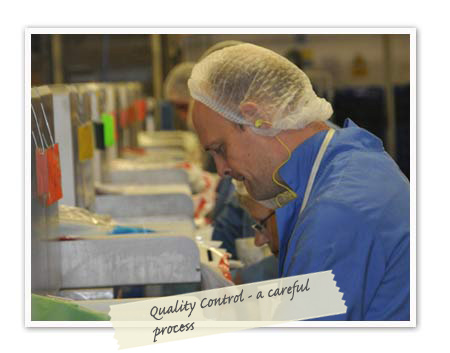Warwick House, Unit 7, Long Bennington Business Park, Main Road, Long Bennington, Newark, Notts, NG23 5JR
+ 44 (0) 1400 283090 generaladmin@bfff.co.uk

SHARE THIS POST
If you have eaten crispy duck, bought frozen duck in a supermarket or enjoyed duck à l’orange in a smart restaurant, then it is more than likely that you have eaten one of Cherry Valley Farms’ ducks.

We set out early to ensure we caught our story.
On a sunny morning in April 2010 Brian Kenyon met me and the Fresh from the Freezer team at Newark train station in Lincolnshire and drove us all to the farm where Cherry Valley rear their ducks. Brian ensured that we all wore hygienic overalls before we entered the barn.
I was immediately surprised by the light, the space, the cleanliness and the fresh smell. This was not the image of poultry farming that I was expecting! I decided to delve deeper…
I was amazed at the room these ducks were given.
Brian advised me that EU regulations allow up to 25 kg of duck per square metre of floor area and went on to say that Cherry Valley provides much more space than this – The ducks in this house being used for frozen production are accommodated at only 17 kg per square meter. This is improving on regulations by some margin!
I asked Brian why this is the case and he told me that Cherry Valley have their own standards – standards that are higher than most! He said that more living space equals a happier bird. And a happier bird is one that is less stressed and one that is therefore stronger and less susceptible to illness. They taste better too!
Brian had been working with Cambridge University finding out what’s best for the duck.
Cherry Valley has been working closely with the RSPCA and Cambridge University to uncover what contributes to normal behaviour in ducks – with a view to them having the best possible welfare. As a result, Brian has also introduced paddling areas to for duck going into fresh production and this is having a positive result. Access to water allows ducks to paddle, preen and enjoy an environment closer to that out in the wild. Have a look at the video we shot and see for yourself! The ducks really do look to have the best welfare.
Whilst we were at the farm Brian and his team were giving the birds their new bedding.
This happens every day so that the ducks can enjoy a clean living space. Also, the ducks are now enjoying their new paddling areas so much that the surrounding straw can get a bit damp. So, new straw every day is very important! But, just when I was thinking that these ducks have it good, Brian continued…
“The ducks are fed a balanced diet of locally grown wheat, traditional soya and a balance of minerals and vitamins. They have no growth promoters and no antibiotics”.
Ensuring that the ducks stay healthy is most important.
So, if the birds are receiving no antibiotics or vaccinations I asked how they stay healthy. Brian told me “This is the reason why we’re wearing these funny looking overalls! Strict hygiene and disinfection ensures that the birds stay healthy and why these particular ducks, a unique Cherry Valley breed of Pekin duck, are naturally hardy animals”.
I was advised that duck farming has changed a lot over the years. Not so long ago, duck farming was seasonal with the eggs only being laid in spring. But now, with modern hatchery processes, the eggs are laid all year round. 28 days after being incubated the young ducks arrive at the farm and stay for seven weeks where, I have to say, they enjoy a very high standard of living.
I was told that much of our duck is imported from the Far East and I doubt they go to these lengths that exceed EU standards.

It’s a short journey so, with a skip and a jump, we’re there!
So, this has so far been a very surprising introduction to frozen food! And, with all this fresh in mind we head off to the plant where the birds are processed. Cherry Valley ensures that all of its farms are close to the processing plant so that the birds are not stressed when they arrive and so the drive doesn’t take long.
We arrived at the plant and again we all got togged up in hygienic overalls before Mark Lovell, the senior supervisor, took us inside. I was immediately struck by how labour intensive the process was. The factory was filled with busy people. It’s amazing how nowadays, even with modern machinery, it is important to have human eyes checking for quality.

Mark explained to me how the birds are washed after they have been prepared for freezing and grading. After they are washed they are hung upside down on a conveyor belt specifically to let them drip dry. Determined to earn my role as an investigative journalist I continued my tour…
Wow!
The automated efficiency in the duck plant is quite amazing.
The birds are graded, weighed and packed accordingly. The most important thing to note is that every bird arrives to the plant in batches that are thoroughly recorded and documented. This way each bird, even when it gets as far as the shop shelves, is traceable to the very farm it came from and the exact time and date it arrived at the Cherry Valley processing plant.

Danes like ’em big!
Some of the ducks are prepared for export (I discovered, for example, that the Danish like very big birds!) and many are sent to Spain, Portugal, Germany and other nations within Europe – anywhere in fact that demands the best quality ducks!


I watched the birds being shrink-wrapped and labelled according to weight and boxed in batches. Mark then suggested we visit the freezer and I soon discovered that I had not come prepared for a near arctic experience!

Brrrrrr!
I have never experienced such cold temperatures!
We entered the walk in freezer which was the size of a small house; albeit one that has not paid its heating bill for a while! The room was an incredible -30°C with a gale force arctic wind! And, it only took a few seconds before it became quite unbearable!

Quick freezing ensures that all the goodness is locked in.
The temperature was so low so that the birds are frozen very quickly. This ensures that the meat keeps its texture. I was told home freezers are not as good at freezing food because they are built to simply keep things cold they only freeze things very slowly and this allows large ice crystals to form during the freezing which alters the texture for the worse.
I think I’ve seen everything now; these ducks were certainly looked after well.
Quick freezing at Cherry Valley ensures that the duck meat retains its taste, texture and nutrients for longer. And lastly, perhaps because Mark thought we were now hardened to the low temperatures and acclimatised to a more hardy life, we were taken to the frozen storage room. To my relief this one was a milder temperature, only –18°C and we witnessed the enormity of the operation. Shelves of frozen duck as high as a large house were on rolling shelves waiting to be taken to restaurants and supermarkets around the country. As we inspected the site, a forklift truck lifted a pallet of newly frozen duck as high as four storeys where it will stay, ‘frozen fresh’, until it’s needed for the supermarket shelves!
SHARE THIS POST

Warwick House, Unit 7, Long Bennington Business Park, Main Road, Long Bennington, Newark, Notts, NG23 5JR
+ 44 (0) 1400 283090 hello@frozenfoodrevolution.co.uk
T&Cs Privacy Policy @bfff frozen food revolution 2024
Website Designed & Built by we are CODA